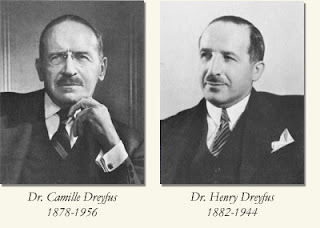Before synthetic fibres existed the United States was becoming the world's major superpower. With this came a new look into science as well as the determination to become less dependent on European and Asian countries and their products- at the time silk was still a major import and applied to much of the clothing worn by Americans. With industrialization and technological advances soaring, synthetic fibres came into existence, chemically produced polymers that changed how we perceived the world.
Source: http://www.fibersource.com/f-tutor/history.htm
http://www.ucmp.berkeley.edu/history/hooke.html
Source: http://www.fibersource.com/f-tutor/history.htm
http://www.chm.bris.ac.uk/motm/nylon/nylonv.htm
Nylon: Nylon had to be one of the more popular fibres ever created. With its flexibility, little corrosion, easy to color, resistant to many chemicals and biodegradable features, it grew to encompass not only daily life but also the second world war that hit as well. Mostly used in toothbrushes in 1938, Du Pont (the manufacturer founded after nylon's discovery) began using the synthetic material for women's stockings. They easily became the new fashion in America, a must-have for every woman. Above is a famous example of a nylon debut at the 1939 World's Fair in New York.
Souce: http://www.chm.bris.ac.uk/motm/nylon/nylonv.htm
Fibres and World War Two: Despite this, the oncoming war cut this luxury short, as all the nylon was mobilized toward the military in better flak vessels, vehicle tires, tents, ponchos, and parachutes as can be seen above as a wave of paratroops land in Holland (which were initially made from silk imported from Japan)
Source: http://www.fibersource.com/f-tutor/history.htm
http://www.manufacturing.net/news/2015/10/80-years-nylon-%E2%80%94-duponts-miracle-textile
Growing Fibres Demand: With the flurry of wartime, the demand for synthetic fibres was astounding. Not just nylon, but acetate, and even rayon (though we no longer use it today) were popular. The initial release of Du Pont's stockings for women in May of 1940 sold over 5 million pairs the first day. In 1941 with the emergence into the war, American women went without new stockings for a long time -the prices for them grew astronomically, moving from $1.25 per pair to $10. Movie stars auctioned off their own hosiery for as much as $40,000 to raise money for the war effort, and Du Pont's rare release of a few pairs during wartime resulted in "Nylon Riots." Demand wasn't fulfilled until the spring of 1946 when the war ended in the summer of 1945, and by that time several stores were still being hit hard by the amount of women buying stockings. One store in San Francisco had to close when over 10,000 women mobbed the place in search of the nylon fashion.
Source: http://www.chm.bris.ac.uk/motm/nylon/nylonv.htm
http://www.fibersource.com/f-tutor/history.htm
New Fibre, New Options: Post-war time called for new synthetic fibres to come into play. Because this type of material was quickly replacing that of imported silk and cotton, three different manufactured fibres were born: metallized fibres (such as steel wire, plastic coated metal and aluminum yarns), modacrylic fibre (used in apparel linings, hair in wigs, scatter rugs, etc.) and olefin fibre (wallpaper, carpets, rope and vehicle interiors). Acrylics which were popularly used in furniture and upholstery, and polyester were also making a statement in markets everywhere in the U.S.
Source: http://www.fibersource.com/f-tutor/history.htm
Fabrics: Clothing was probably the most affected by synthetic materials. By 1952, a new term, "wash and wear" was coined, as the commercialization of polyester grew to new heights due to the introduction of triacetate, which essentially meant that clothing came out of the dryer relatively wrinkle-free. Ironing became a thing of the past as industries began to experiment with the physical properties of these new synthetic fibres so that they were more durable, more comfortable, and more permanent. Different colors and dyeing options also became more popular, especially with stockings. Up above is an advertisement for color-tinted stockings.
Source: http://www.fibersource.com/f-tutor/history.htm
Synthetic Fibres Go to Space: It's not surprising that people were taking their synthetic fibres to new heights (HA HA). Suits for space exploration were also altered to suit the U.S Space Program in the late 1960s, from giving suits several layers of nylon and aramid (a heat resistant fibre that is mostly used in aerospace of military applications), to putting nylon on the nose cones of the spaceship and using over 30,000 pounds of carbonized nylon in their exhaust nozzles. Above is Neil Armstrong in a space suit consisting of these synthetic fibres -he was the first to prove that these man-made fabrics worked perfectly, even in outer space. The flag he planted on the moon was even made of nylon.
Source: http://www.fibersource.com/f-tutor/history.htm
Source: https://www.epa.gov/eg/organic-chemicals-plastics-and-synthetic-fibers-effluent-guidelines
http://www.fibersource.com/f-tutor/history.htm
Source: http://www.manufacturing.net/news/2015/10/80-years-nylon-%E2%80%94-duponts-miracle-textile
http://www.fabriclink.com/university/history.cfm
Below is the commercialization of the most common synthetic fibres used to this day (other than rayon):
| 1910 — Rayon | 1941 — Saran | 1959 — Spandex | ||
| 1924 — Acetate | 1946 — Metallic | 1961 —Aramid | ||
| 1930 — Rubber | 1949 — Modacylic | 1983 — PBI | ||
| 1936 — Glass | 1949 — Olefin | 1983 — Sulfar | ||
| 1939 — Nylon | 1950 — Acrylic | 1992 — Lyocell | ||
| 1939 — Vinyon | 1953 — Polyester |








No comments:
Post a Comment